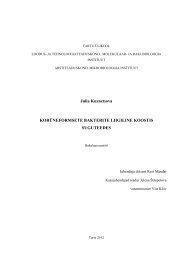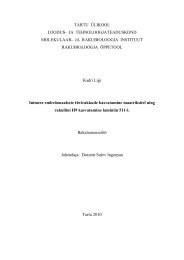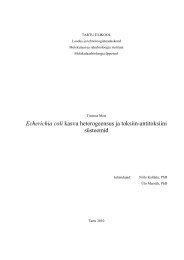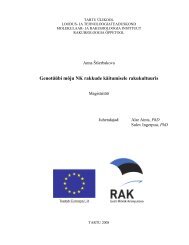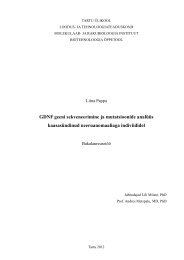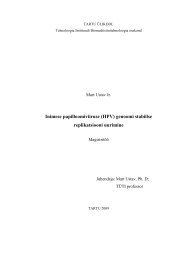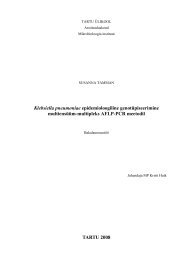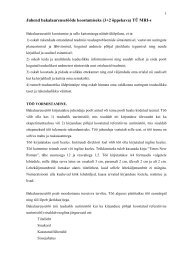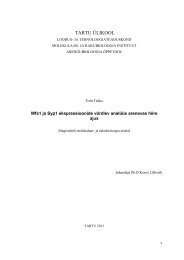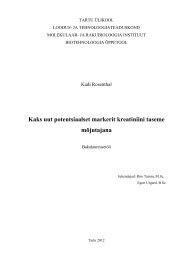Viruses and RNA interference in mammalian cells
Viruses and RNA interference in mammalian cells
Viruses and RNA interference in mammalian cells
Create successful ePaper yourself
Turn your PDF publications into a flip-book with our unique Google optimized e-Paper software.
mi<strong>RNA</strong>s are taken from the nucleus to the cytoplasm by Ran-GTP <strong>and</strong> the export receptor<br />
Export<strong>in</strong>-5 (Yi et al., 2003; Lund et al., 2004). Pre-mi<strong>RNA</strong>s are processed by Dicer <strong>in</strong>to<br />
mi<strong>RNA</strong>s. Hence, mi<strong>RNA</strong>s are produced endogenously (Carmell <strong>and</strong> Hannon, 2004).<br />
Drosha - RNase III, nuclease that executes the <strong>in</strong>itiation step of mi<strong>RNA</strong> process<strong>in</strong>g <strong>in</strong> the<br />
nucleus: processes pri-mi<strong>RNA</strong> to pre-mi<strong>RNA</strong> (Lee et al., 2003) (Figure 5). This nuclear<br />
RNase III enzyme, which was first discovered <strong>in</strong> humans <strong>and</strong> subsequently <strong>in</strong> Drosophila<br />
<strong>and</strong> C. elegans, is implicated <strong>in</strong> <strong>in</strong>itiation of the mi<strong>RNA</strong> pathway (Tang, 2005).<br />
Molecular mechanism of <strong>RNA</strong>i <strong>in</strong> <strong>mammalian</strong> <strong>cells</strong><br />
In <strong>mammalian</strong> <strong>cells</strong>, si<strong>RNA</strong>s are also produced with the help of Dicer from ds<strong>RNA</strong>.<br />
Mammals encode only one Dicer gene, while for <strong>in</strong>stance the plant Arabidopsis thaliana,<br />
encodes four different Dicer-like (DCL) genes (van Rij <strong>and</strong> And<strong>in</strong>o, 2006). Dicer is<br />
complexed with the TAR-<strong>RNA</strong> b<strong>in</strong>d<strong>in</strong>g prote<strong>in</strong> (TRBP), which b<strong>in</strong>ds to the transactivation<br />
response element (TAR) of <strong>RNA</strong>s through different sites (Dor<strong>in</strong> et al., 2002), <strong>and</strong> delivers<br />
the si<strong>RNA</strong>s to the RISC. Its core components are the Argonaute family prote<strong>in</strong>s. Only Ago-<br />
2 possesses an active catalytic doma<strong>in</strong> for cleavage activity <strong>in</strong> humans. The Ago-2 prote<strong>in</strong><br />
cleaves the target m<strong>RNA</strong>s between 10 <strong>and</strong> 11 bases, relative to the 5′ end of the antisense<br />
si<strong>RNA</strong> str<strong>and</strong> (Aagaard <strong>and</strong> Rossi, 2007)<br />
Figure 5. Human AGO2 <strong>and</strong> Drosha. Ago prote<strong>in</strong>s conta<strong>in</strong> PAZ doma<strong>in</strong>s. Ago prote<strong>in</strong>s carry an extra PIWI<br />
doma<strong>in</strong>. The PIWI doma<strong>in</strong> is a prote<strong>in</strong> doma<strong>in</strong> homologous to PIWI prote<strong>in</strong>s. <strong>RNA</strong>se III doma<strong>in</strong>s (RIIIa,<br />
RIIIb) are the parts of Drosha. Drosha also conta<strong>in</strong>s double-st<strong>and</strong>ed <strong>RNA</strong> b<strong>in</strong>d<strong>in</strong>g doma<strong>in</strong>s (dsRBDs). (Meister<br />
<strong>and</strong> Tuschl, 2004).<br />
12



